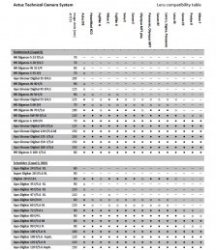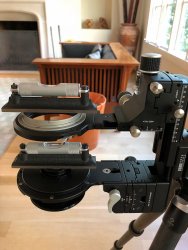I would like to share my experiences working with the Fuji 50s (also applies to 50r) on a technical camera. I wanted to increase the pixel count slightly and decided to shift in portrait position. The slightly smaller size of the sensor allows for greater shifts without stressing lens performance.
This applies to any technical camera - I happen to use an Actus. The Actus can shift to 22mm (the shift stop limit) left and right which just happens to equate to a16X9 format. A very slight crop is needed as the vertical doesn’t quite fit perfectly (probably would have needed 24mm shift) but this is very negligible. 4 shots are necessary for this format size and depending on the lens used and the lens type an LCC may be necessary for the two outer shift images. I have found that my 72mm needs LCC’s for the two outer shift images. This is extremely simple with the Fuji vs. a Phase as all that is necessary is to place the diffuser in front of the lens and shoot - no need to manually set shutter speed for the correct exposure as all of that is accomplished automatically. Of course all of this requires C1 which I know all of you have…..
I have tried this with all of my Schneider lenses 72, 100, 120, 150, 180 with outstanding results. I am able to use the short rail on my Actus for all of these lenses so the entire camera system is really small. Even the extreme edges of the most shifted images are very sharp with all lenses.
So what is the real benefit of shifting this way vs. shifting in landscape orientation? Real Estate!! The lens FOV is increased substantially which, for me, is needed if I want a lens wider than 72mm.
Focus and parallelism are both critical. It doesn’t matter how you determine parallelism but it is critical (not done by any type of detent unless trusted). The same with focus. I have found that its best to focus with the outer edges of the maximum shifts and then check again for center sections. It’s also good to have a feel for how a lens reacts to the Fuji peaking. A little practice goes a long way.
Hope this is helpful for any Fuji/Tech users.
Cheers…….
Victor
This applies to any technical camera - I happen to use an Actus. The Actus can shift to 22mm (the shift stop limit) left and right which just happens to equate to a16X9 format. A very slight crop is needed as the vertical doesn’t quite fit perfectly (probably would have needed 24mm shift) but this is very negligible. 4 shots are necessary for this format size and depending on the lens used and the lens type an LCC may be necessary for the two outer shift images. I have found that my 72mm needs LCC’s for the two outer shift images. This is extremely simple with the Fuji vs. a Phase as all that is necessary is to place the diffuser in front of the lens and shoot - no need to manually set shutter speed for the correct exposure as all of that is accomplished automatically. Of course all of this requires C1 which I know all of you have…..
I have tried this with all of my Schneider lenses 72, 100, 120, 150, 180 with outstanding results. I am able to use the short rail on my Actus for all of these lenses so the entire camera system is really small. Even the extreme edges of the most shifted images are very sharp with all lenses.
So what is the real benefit of shifting this way vs. shifting in landscape orientation? Real Estate!! The lens FOV is increased substantially which, for me, is needed if I want a lens wider than 72mm.
Focus and parallelism are both critical. It doesn’t matter how you determine parallelism but it is critical (not done by any type of detent unless trusted). The same with focus. I have found that its best to focus with the outer edges of the maximum shifts and then check again for center sections. It’s also good to have a feel for how a lens reacts to the Fuji peaking. A little practice goes a long way.
Hope this is helpful for any Fuji/Tech users.
Cheers…….
Victor



